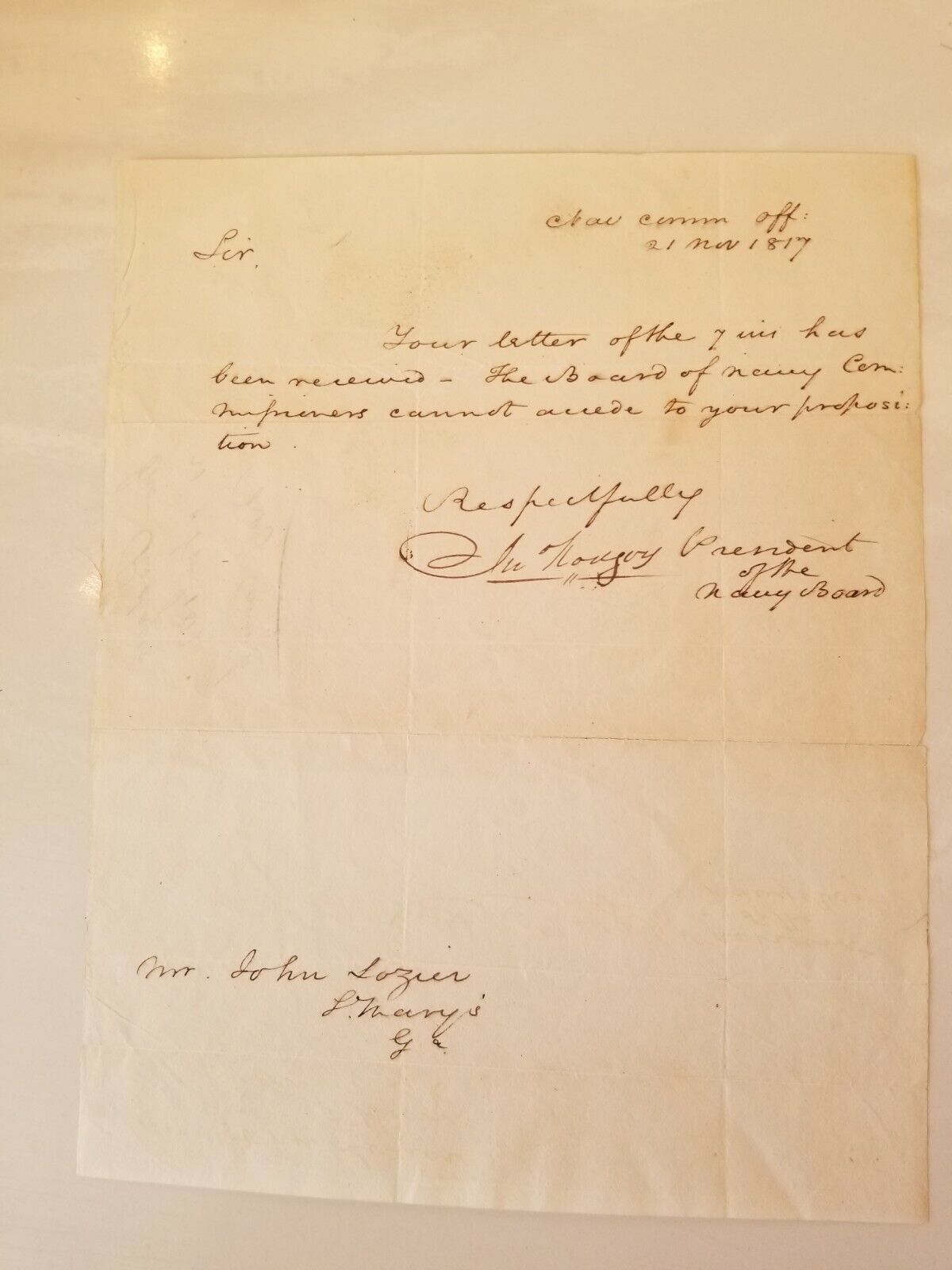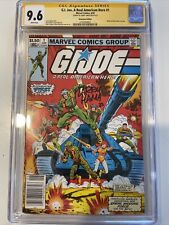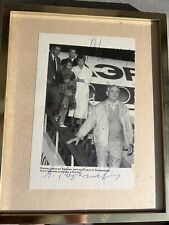|

On eBay Now...
Rare Signed BARBARY WAR OF 1812 HERO US NAVY COMMODORE JOHN RODGERS 1817 LETTER For Sale

When you click on links to various merchants on this site and make a purchase, this can result in this site earning a commission. Affiliate programs and affiliations include, but are not limited to, the eBay Partner Network.

Rare Signed BARBARY WAR OF 1812 HERO US NAVY COMMODORE JOHN RODGERS 1817 LETTER:
$779.99
JOHN RODGERS Early American V. I. P. (1772 – 1838) WAR OF 1812 HERO COMMODORE, US NAVY Rodgers became a hero in the pre-War of 1812 Naval squabbles with France and Great Britain. He served with distinction in the Quasi-War with France, helped to defeat Tripolitan naval forces in the Barbary Wars and defeated a British Sloop-of-War in 1811, which brought back a measure of respect to the United States Navy in the wake of the USS Chesapeake-HMS Leopold affair. During the War of 1812, Rodgers commanded several squadrons that were crushed in battle, but helped to successfully defend Baltimore from British attack. After the War, he was named President of the United States Navy Board of Commissioners (which included fellow Commodores Isaac Hull and David D. Porter). HERE’S AN UNCOMMON AUTOGRAPH LETTER SIGNED BY John Rodgers - Naval officer, War of 1812. Autograph letter signed, 1 page, 4to, November 21, 1817 to John Lozier. Rodgers sends a brief letter of regret that the Board of Naval Commissioners cannot grant Lozier’s request. Research shows that Lozier is a possible military soldier who served in the Revolutionary War as well as the War of 1812. There is also a pencil signature on the reverse thought to be a clerk for the Navy Commission. This letter is signed by Commodore John Rodgers who was the President of the Navy Commission at the time of the letter being signed. The letter has deep horizontal fold tears which need to be repaired before there is a clean separation of the letter text. The signature is fine. The letter is reinforced on the ends on the reverse side with some pH neutral repair tape. This is clear non-acidic archival tape but not easily removed. That will protect it somewhat for handling and possible framing if that is your intent.
*sales estimates for official Commodore Rodgers military signed documents go as high as $1,200. There are other later dated documents with much higher sales results. A RARE ADDITION TO YOUR AMERICAN NAVAL HISTORY AUTOGRAPH, MANUSCRIPT & EPHEMERA COLLECTION! BIOGRAPHY OF COMMODORE JOHN RODGERS John Rodgers (1772–01 August 1838), naval officer, was born near Havre de Grace, Maryland, the son of John Rodgers and Elizabeth Reynolds, farmers who also kept a tavern and owned mills. Rodgers, after attending the village school, was apprenticed to a Baltimore shipowner. Like many of his contemporaries, he rose to command a merchant ship while still in his teens, trading to Western Europe. Rodgers spent eleven years in the merchant service before being commissioned a lieutenant in the new U.S. Navy in 1798. He was appointed second lieutenant of the frigate Constellation under Captain Thomas Truxtun, and when the first lieutenant resigned soon afterward, Rodgers became Truxtun’s executive. From this most influential of the navy’s first generation of captains Rodgers learned not only naval tactics but the art of managing the complex organization of a naval ship. As Constellation’s first lieutenant, Rodgers took a prominent part in the capture of the frigate Insurgente in 1799, the most dramatic action of the Quasi War with France. He was promoted to captain in March 1799 and commanded the ship Maryland through the remainder of the war. As a very junior captain, he was nearly eliminated from the navy list in the Peace Establishment of 1801, but his early association with the Smith family of Baltimore stood him in good stead when Robert Smith became secretary of the navy in the Jefferson administration. Rodgers survived as the eighth of twelve captains on the list and was given command of the frigate John Adams in the squadron sent to the Mediterranean under Richard V. Morris in 1802. He headed the blockading ships on the coast of Tripoli and engaged in some skirmishes with the Tripolitan forces before succeeding Morris in command of the squadron; however, he was almost immediately superseded by the commander of the replacement squadron, Edward Preble. Rodgers swallowed his disgust and dismay long enough to support Preble with his ships in a successful negotiation at Tangier and then returned to the United States. He reached the Mediterranean again in the Samuel Barron squadron, sent in relief of Preble, and remained to command the squadron after Barron had concluded peace with Tripoli and returned home. Rodgers’s squadron was withdrawn in 1806. Rodgers was never involved in a duel, but he flirted with the prospect more than once. His closest call was in the fall of 1806 when, almost immediately after reaching the United States, he demanded satisfaction from Captain James Barron for alleged insults said to have been spread by the latter in Rodgers’s absence. The real cause for the bad feeling between the two was Rodgers’s suspicion that Barron had worked to dissuade his elder brother Samuel from turning his squadron over to Rodgers, even when Samuel Barron was seriously ill and unable to function. Before the duel could take place, Rodgers professed himself satisfied. His reluctance to duel may have been related to the fact that, on 21 October 1806, he married Minerva Denison of Havre de Grace; the couple eventually had eleven children, ten of whom survived infancy. In spite of the bad feeling between the two captains, the small number of officers of that rank in the navy necessitated the selection of Rodgers to preside over James Barron’s court-martial after the Chesapeake-Leopardincident in 1807. Barron was convicted on one charge and given a five-year suspension. When the navy’s large vessels were ordered out again to enforce the Embargo and Non-Intercourse acts, Rodgers, now the navy’s senior captain, took command of the northern cruising squadron in the Constitution. Dissatisfied with the frigate’s performance, he exchanged with Isaac Hull in 1810, taking the frigate President, which remained his command until 1814. Although Rodgers was greatly respected for his administrative abilities, heroism at sea evaded him throughout his career. Before and during the War of 1812 he displayed a curious inability to make an accurate estimate of the size of a potential opponent. In May 1811, while cruising off the Atlantic coast to protect American commerce, he engaged the much smaller British sloop of war Little Belt in a night action. In his first wartime cruise, his squadron pursued the frigate Belvidera, but the quarry escaped by superior management. Rodgers was wounded in the action, suffering a broken leg from the explosion of a cannon. In three subsequent cruises, Rodgers captured a significant number of merchant vessels but failed to encounter a naval ship. In the North Sea in 1813 he retreated from a British frigate that he mistook for a ship of the line, and off New York in 1814 he made a similar error. He then left the President to take command of the new frigate Guerriere under construction at Philadelphia, and while waiting for that ship to be finished he joined the land forces in the defense of Chesapeake Bay in the fall of 1814. Both his skills and seniority made Rodgers the logical choice to head the new Board of Navy Commissioners constituted in 1815. The remainder of his naval service consisted of two terms as president of that board, from 1815 to 1824 and from 1827 to 1837, interrupted only by a two-year cruise in command of the Mediterranean squadron. The commissioners succeeded in giving the first systematic organization to naval administration, especially with regard to matters such as construction and supply. Rodgers’s conservative temperament may have retarded some innovations, but the probity of his administration could never be faulted. He set the tone that prevailed throughout the history of the Board of Navy Commissioners, until it was replaced in 1842 by the system of bureaus. Rodgers’s health declined noticeably after he survived an attack of cholera in 1832. He progressively lost his memory and mental agility, until in 1837 he resigned from the Board of Navy Commissioners to travel to Europe for his health. He returned a year later and went to the Naval Asylum in Philadelphia, where he died .Bibliography Important collections of Rodgers’s papers can be found at the Historical Society of Pennsylvania and the New-York Historical Society. The only biography is C. O. Paullin, Commodore John Rodgers (1910). For additional information on Rodgers’s last cruise, see James M. Merrill, “Midshipman Dupont and the Cruise of North Carolina, 1825–1827,” American Neptune 40, no. 3 (1980): 211–25, based on S. F. du Pont’s letters. [Source: American National Biography] John Rodgers (August 8, 1812 – May 5, 1882) was an admiral in the United States Navy. He began his naval career as a commander in the American Civil War and during his Postbellum service became an admiral. Rodgers\' father was Commodore John Rodgers (1772–1838), and he was the grandfather of pioneering Naval aviator Commander John Rodgers (1881–1926). Six ships of the United States Navy have been named in their honor; either as USS John Rodgers or USS Rodgers. > HISTORY PROVENANCE OF PURCHASE ORIGIN This item was originally offered by Custodians of History, Inc. Dealer primarily in historic autographs. The piece came with a written lifetime refund guarantee for authenticity, offered to the original buyer (included with the purchase and shown in pics). Custodians of History Inc. is a member of the Professional Autograph Dealers Association and Manuscript Society.


GI Joe #1 1982 Marvel CGC Graded 9.6 Newsstand Edition Signed Larry Hama. Rare $747.00

RARE ITHACA GUNS PINUP BIKINI BABE PORCELAINFIREARM SERVICE GASSTATION PUMP SIGN $130.00

Rare Famous Simon Reyes Handmade Pottery Rabbit Sign Whistle $25.99

Vintage FIBERGLASS Tornado Shelter Sign VERY RARE 12" X 6" Made in 1950s 1960s $34.95

2 Diff Peter Putter Cardboard Easel Signs C 1940’s Paint Interest Schalk’s Rare $174.99

Mormon Polygamist 1955 - Collier's 11 x 16 - RARE ORIG Advertising Store Sign - $99.00

🔥RARE Spider's Web 1990 Ed Red Web-Stamped Spider-Man 1 SET Signed by McFarlane $399.97

RARE Signed By Mikhail Gorbachev & Wife Raisa PHOTO Page “Anatomy Of Putsch” $325.00
|